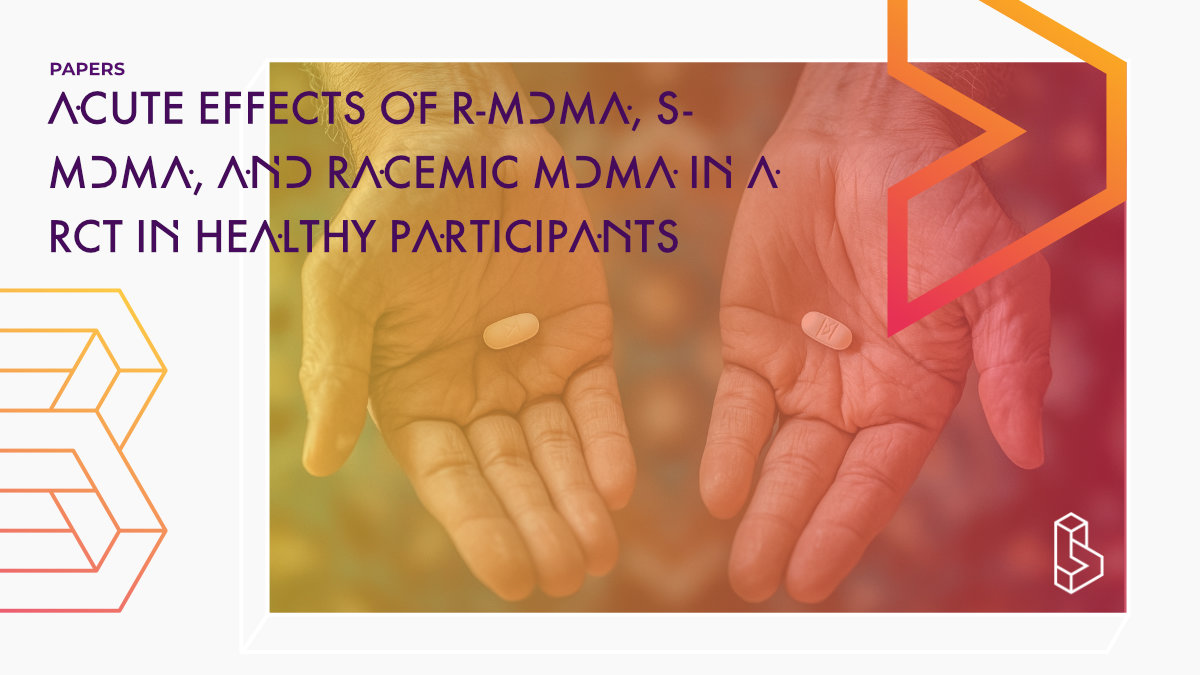This double-blind, randomized, placebo-controlled, crossover study (n=24) compares the acute effects of MDMA, S-MDMA, R-MDMA (the left and right-handed parts of MDMA), and placebo in healthy participants. It finds that S-MDMA (125 mg) induced stronger subjective effects and higher increases in blood pressure than R-MDMA and racemic MDMA while also increasing plasma prolactin, cortisol, and oxytocin more significantly. The study also notes differences in elimination half-lives and metabolite concentrations between the different forms of MDMA.
Abstract of Acute effects of R-MDMA, S-MDMA, and racemic MDMA in a randomized double-blind cross-over trial in healthy participants
“Racemic 3,4-methylenedioxymethamphetamine (MDMA) acutely increases mood, feelings of empathy, trust, and closeness to others and is investigated to assist psychotherapy. Preclinical research indicates that S-MDMA releases monoamines and oxytocin more potently than R-MDMA, whereas R-MDMA more potently stimulates serotonin 5-hydroxytryptamine-2A receptors. S-MDMA may have more stimulant properties, and R-MDMA may be more psychedelic-like. However, acute effects of S- and R-MDMA have not been examined in a controlled human study. We used a double-blind, randomized, placebo-controlled, crossover design to compare acute effects of MDMA (125 mg), S-MDMA (125 mg), R-MDMA (125 mg and 250 mg), and placebo in 24 healthy participants. Outcome measures included subjective, autonomic, and adverse effects, pharmacokinetics, and plasma oxytocin, prolactin, and cortisol concentrations. S-MDMA (125 mg) induced greater subjective effects (“stimulation,” “drug high,” “happy,” “open”) and higher increases in blood pressure than R-MDMA (both 125 and 250 mg) and MDMA (125 mg). Unexpectedly, R-MDMA did not produce more psychedelic-like effects than S-MDMA. S-MDMA increased plasma prolactin more than MDMA, and S-MDMA increased plasma cortisol and oxytocin more than MDMA and R-MDMA. The plasma elimination half-life of S-MDMA was 4.1 h after administration. The half-life of R-MDMA was 12 and 14 h after the administration of 125 and 250 mg, respectively. Half-lives for S-MDMA and R-MDMA were 5.1 h and 11 h, respectively, after racemic MDMA administration. Concentrations of the CYP2D6-formed MDMA-metabolite 4-hydroxy-3-methoxymethamphetamine were lower after R-MDMA administration compared with S-MDMA administration. The pharmacokinetic findings are consistent with the R-MDMA-mediated inhibition of CYP2D6. Stronger stimulant-like effects of S-MDMA in the present study may reflect the higher potency of S-MDMA rather than qualitative differences between S-MDMA and R-MDMA. Equivalent acute effects of S-MDMA, MDMA, and R-MDMA can be expected at doses of 100, 125, and 300 mg, respectively, and need to be investigated.”
Authors: Isabelle Straumann, Isidora Avedisian, Aaron Klaiber, Nimmy Varghese, Anne Eckert, Deborah Rudin, Dino Luethi & Matthias E. Liechti
Summary of Acute effects of R-MDMA, S-MDMA, and racemic MDMA in a randomized double-blind cross-over trial in healthy participants
MDMA, also known as 3,4-methylenedioxymethamphetamine, is a psychoactive substance that produces acute effects including elevated mood, increased feelings of empathy, trust, and closeness to others. It is currently being investigated as a potential adjunct to psychotherapy, particularly for conditions like post-traumatic stress disorder. MDMA is a racemic compound, meaning it contains equal amounts of two mirror-image molecular structures called enantiomers: S(+)-MDMA and R(-)-MDMA.
Previous preclinical research has suggested that these two enantiomers may have differing effects. S-MDMA appears to more potently release monoamine neurotransmitters and oxytocin compared to R-MDMA. In contrast, R-MDMA may have a stronger effect on serotonin 5-HT2A receptors. Animal behavioural studies have indicated that S-MDMA produces more stimulant-like effects, while R-MDMA may have more psychedelic-like properties. Some research has also suggested R-MDMA may cause less hyperthermia and neurotoxicity than S-MDMA.
However, the acute effects of S-MDMA and R-MDMA have not been directly compared in a controlled human study until now. This research aimed to fill that gap by conducting a double-blind, randomised, placebo-controlled crossover study comparing the effects of racemic MDMA, S-MDMA, R-MDMA, and placebo in healthy human participants.
Methods
Find this paper
https://doi.org/10.1038/s41386-024-01972-6
Open Access | Google Scholar | Backup | 🕊
Cite this paper (APA)
Straumann, I., Avedisian, I., Klaiber, A., Varghese, N., Eckert, A., Rudin, D., ... & Liechti, M. E. (2024). Acute effects of R-MDMA, S-MDMA, and racemic MDMA in a randomized double-blind cross-over trial in healthy participants. Neuropsychopharmacology, 1-10.
Study details
Compounds studied
MDMA
Topics studied
Healthy Subjects
Study characteristics
Original
Placebo-Controlled
Double-Blind
Within-Subject
Randomized
Participants
24
Humans
Authors
Authors associated with this publication with profiles on Blossom
Matthias LiechtiMatthias Emanuel Liechti is the research group leader at the Liechti Lab at the University of Basel.
Compound Details
The psychedelics given at which dose and how many times
MDMA 125 - 250mg | 4x

